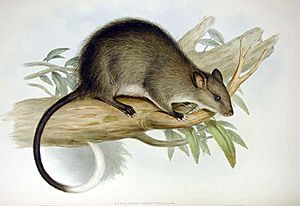Black-footed tree-rat facts for kids
Quick facts for kids Black-footed tree-rat |
|
|---|---|
 |
|
| Conservation status | |
| Scientific classification | |
| Genus: |
Mesembriomys
|
| Species: |
gouldii
|
| Synonyms | |
|
Hapalotis hirsutus Gould, 1842 |
|
The black-footed tree-rat, also called Djintamoonga, is a special type of rat. Its scientific name is Mesembriomys gouldii. This rat is one of only two tree-dwelling (or arboreal) rat species in its group, Mesembriomys. You can find it only in the northern parts of Australia.
It is one of the biggest rat species in Australia.
Contents
What Does the Black-footed Tree-Rat Look Like?
This tree-rat has a shaggy, rough coat that is greyish-brown. Its belly is a creamy white color. Its back feet are black and have strong pads and sharp claws. These help it climb trees.
The black-footed tree-rat has large ears. It also has a long tail with a fluffy brush of white hair at the very tip. These rats can weigh about 830 grams (almost 2 pounds). They are usually about 250 to 310 millimeters (10 to 12 inches) tall. Their body length can be from 320 to 420 millimeters (12 to 16 inches).
How Does the Black-footed Tree-Rat Behave?
The black-footed tree-rat likes to be on its own. It is a nocturnal animal, which means it is active at night. During the day, it rests and shelters in tree hollows. It also hides in stands of pandanus plants. Since it lives in trees, it is known as an arboreal animal.
What Does the Black-footed Tree-Rat Eat?
This tree-rat mainly eats plants. It is a folivore, meaning it eats leaves. It is also a frugivore, meaning it eats fruits. Sometimes, it adds other things to its diet. These can include small invertebrates like termites and molluscs (like snails).
Where Does the Black-footed Tree-Rat Live?
The black-footed tree-rat lives across northern Australia. Its home stretches from the savannah areas of the Cape York Peninsula in Queensland. It goes westward all the way to the Kimberley region in Western Australia.
These rats prefer to live in tropical woodlands or open forests. However, they are not very common in these areas. Sadly, their population has gone down quite a bit. In the last ten years, their numbers have dropped by 30 to 50 percent. Scientists estimate there are about 30,000 black-footed tree-rats left.


